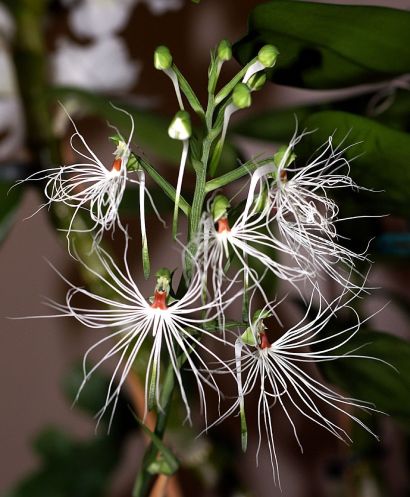Orchid Oddity: Habenaria medusa
March 10, 2014 at 7:00 am smithsoniangardens 5 comments
Anyone who’s seen specimens from the Smithsonian Orchid Collection knows that this most diverse and species-rich plant family can display truly bizarre yet strangely beautiful forms. Literally every day, some improbable flower comes into bloom in our greenhouses. But there is one plant that invariably causes jaws to drop when viewed in full bloom. Most onlookers agree it is among our most spectacular and prized orchid species in the collection.

Habenaria medusa via eol.
Habenaria medusae is a terrestrial orchid from monsoonal habitats in Indonesia and mainland southeast Asia. Producing a basal rosette of leaves from a subterranean corm, the plant is fairly nondescript until it sends up a 20-inch inflorescence bearing ten to twenty or more truly astounding flowers. Most prominent is the outstanding lip, composed of finely dissected, radially arranged fringe reminiscent of Medusa’s head of snakes, from which it gets its name. One might ask why such a lip evolved in the first place; in this case it is still somewhat of a mystery. Thought to be moth-pollinated because of its white color, sweet evening fragrance and nectar spur, the deep fringe is actually a fairly commonplace feature of moth flowers. Though no one knows exactly why, something about these deeply fringed flowers acts as a highly effective attractant to moths.
Habenarias are known for being difficult to cultivate, intolerant of poor or chemically treated water, and needing a strict, dry winter dormant period. They rot easily if watered during their dry season. Despite its sensitive nature, the Smithsonian’s specimen has proven to be more amenable than most to cultivation and has bloomed three times since being purchased as a small bulb from a vendor from Singapore at the World Orchid Conference. This year the plant was selfed (pollinated with its own pollen) to create more seedlings of this delightful species and also crossed with a related species with a deep coral pink lobed lip in the hopes of producing flowers with a colorful medusa lip.
-Tom Mirenda, Smithsonian Gardens orchid specialist
Visit our orchids at the United States Botanic Garden’s exhibit Orchid Symphony, a collaboration between Smithsonian Gardens and USBG, now through April 27th, 2014!
Entry filed under: Collections, Horticulture, Orchids. Tags: Indonesia, orchid exhibit, orchids.
5 Comments Add your own
Leave a comment
Trackback this post | Subscribe to the comments via RSS Feed

1. Patrick Collins | April 25, 2018 at 7:15 pm
Patrick Collins | April 25, 2018 at 7:15 pm
I am pretty certain this species was named for its resemblance to a jellyfish rather than the Gorgon Medusa. The name meduse for jellyfish is used commonly in German (though qualle may be more common?), the language in which the species was described by F.W.L. Kraenzlin. Medusa is more rarely used in English for jellyfish. Looking at the flower the red bell and white tentacles are remarkably like a jellyfish.
I came to this page as it was linked from a new Botany Photo of the Day entry at the University of British Columbia.
2. smithsoniangardens | April 26, 2018 at 1:58 pm
smithsoniangardens | April 26, 2018 at 1:58 pm
Interesting, it does look like a jelly fish! Thanks for sharing.
3. smithsoniangardens | April 7, 2015 at 2:55 pm
smithsoniangardens | April 7, 2015 at 2:55 pm
Hi Terry,
We sent along your comment to Tom, one of our orchid experts, and here’s what he had to say:
“Happily, Habenaria medusa is probably the easiest of the Habenarias to grow. You can remove the media in the fall but be sure to keep them dark and dry over the winter – usually wrapped in a plastic sip-lock bag. I’ve not had to apply a fungicide, but I also don’t bare-root them. Generally, I repot in fresh mix in the spring as they come out of dormancy. I’ve heard they can be susceptible to rot so I don’t think dusting them with fungicide would hurt. These do NOT want to be cool while dormant! Just dry, not cold. They emerge on their own as temperatures and day lengths increase in the spring (just about this time of year). I just started watering our Habenarias at the Smithsonian Greenhouses this week! These plants are really not that picky about medium. Pro mix works. Fine bark mixed with peat or coir is OK too. I would think they would also do well in a sandy mix and might try it this year on a couple.”
Hopefully this is helpful. Good luck!
Smithsonian Gardens
4. Terry Letendre | April 8, 2015 at 9:08 pm
Terry Letendre | April 8, 2015 at 9:08 pm
Thanks for the tips. I bought some in the fall one year and kept them in the fridge thinking this was what I should do, they never did grow again. This time I just got them 2 weeks ago and they are already showing signs of growth so I wanted to do a better job this time.
Thanks again
Terry
5. Terry Letendre | April 2, 2015 at 6:50 pm
Terry Letendre | April 2, 2015 at 6:50 pm
I recently bought a few from a vendor at an orchid show and wondered how you grow it. The vendor said he removed them from the media in the fall. I wondered if you then dust them with something like bulb dust to prevent rot during storage and whether you store them in refridgeration during the dormant period. If you do will they sprout in the cool environment or do they need to be put in a warmer place to initiate the spring sprout. Finally what medium do you plant them in, soil less seedling mix, houseplant soil or sphagnum moss or something else.
Any help is most appreciated.
Terry Letendre